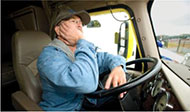Staying Awake Means Staying Alive
 Patrick Hartley, MD, MPH Patrick Hartley, MD, MPH
Medical Director, WORKSAFE IOWA and UI HealthWorks
The Federal Motor Carrier Safety Administration of the US Department of Transportation (DOT) has found that as many as 28% of commercial driver’s license holders have a sleep disorder known as “sleep apnea.”1
In this condition, a sleeper’s airway collapses or is blocked and breathing becomes shallow or stops temporarily, with a resulting drop in blood oxygen that disrupts sleep. This breathing pause, or “apnea,” can occur 5-30 times or more an hour during sleep. In waking hours, the individual may experience sleepiness, falling asleep at inappropriate times, lack of concentration, and memory impairment— symptoms that are potentially deadly for commercial drivers.2
 We occupational medicine providers who are responsible for medically certifying drivers consider various factors to diagnose the condition, related to We occupational medicine providers who are responsible for medically certifying drivers consider various factors to diagnose the condition, related to
- anatomy: a relatively large neck, a small or recessed jaw, a small airway in the nose, throat, or mouth (either due to structure or congestion)
- health: Body Mass Index (BMI—a height-weight ratio), high blood pressure, Type 2 diabetes, hypothyroidism
- history: heavy snoring, daytime sleepiness, frequent awakenings, experience of a single-vehicle crash
We also base our diagnosis on objective data from sleep testing. Once a diagnosis is made, we will likely certify a driver for no more than one year.
For drivers to receive ongoing yearly certification, they need to show that they are following through with treatment as prescribed—a common treatment involves the sleeper wearing a mask-like device connected to a Continuous Positive Airway Pressure (CPAP) machine that increases air pressure in the throat. We also reevaluate symptoms and any other information relevant to recertification.
In the course of the DOT physical, the occupational medicine expert will sort out the complexities of this condition, which brings together issues of individual health, public safety, and government regulation.
1 US DOT – FMCSA - Sleep Apnea and Commercial Drivers
2 NIH National Health, Lung, and Blood Institute - What is Sleep Apnea?
|